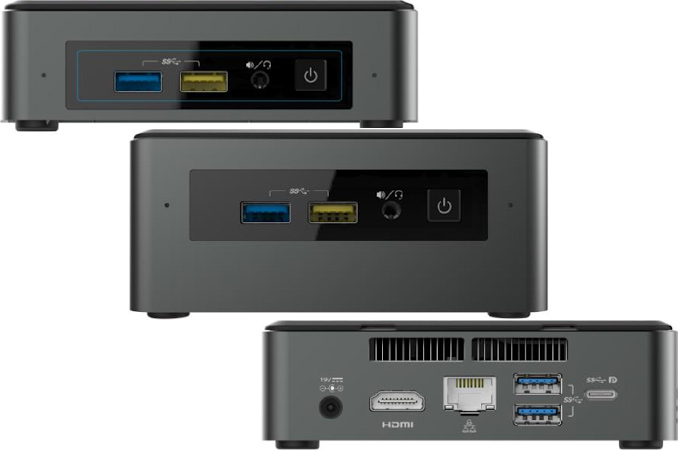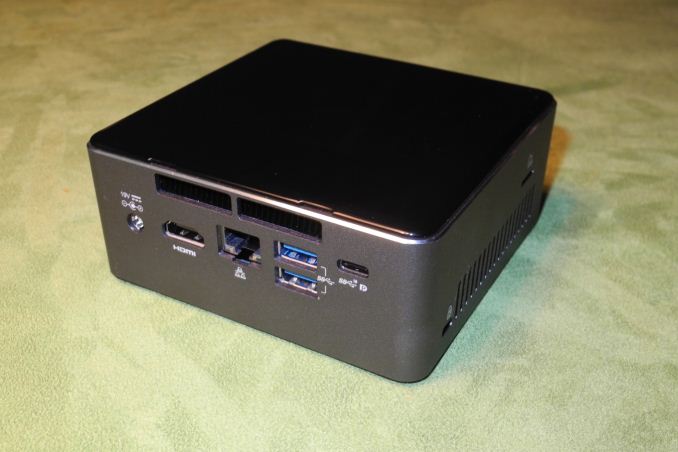Intel Officially Launches Baby Canyon NUCs with Kaby Lake: Thunderbolt Makes a Re-entry
by Ganesh T S on January 17, 2017 2:00 PM EST- Posted in
- Trade Shows
- Systems
- Intel
- HTPC
- NUC
- Thunderbolt 3
- Kaby Lake
- CES 2017

The Baby Canyon NUCs were leaked in July 2016, and Intel officially launched the units at CES 2017. The first-generation NUCs based on Ivy Bridge had a SKU with Thunderbolt support. However, Thunderbolt went missing till it came back in the Skull Canyon NUC (NUC6i7KYK) last year. The Alpine Ridge controller for Thunderbolt 3 also integrates a USB 3.1 Gen 2 controller, making the Type-C Thunderbolt 3 port quite versatile. The Baby Canyon NUCs bring Thunderbolt back into the UCFF NUC form-factor. All the Baby Canyon NUCs have the Alpine Ridge controller. However, the i3 model is limited by firmware, allowing the Type-C port to support only USB 3.1 Gen 2 and Display Port 1.2. The i7 and i5 models have full Thunderbolt 3 support.
The leaked specifications we wrote about in July were more or less accurate, and the official specifications allow us to fill in some of the missing blanks. The updated table is presented below. SKUs ending with K are units that do not support a 2.5" drive (only M.2 SSDs are supported).
| Intel Baby Canyon NUC PCs | |||||
| NUC7i7BNH | NUC7i5BNH | NUC7i5BNK | NUC7i3BNH | NUC7i3BNK | |
| CPU | Core i7-7567U 2C/4T 28 W TDP |
Core i5-7260U 2C/4T 15 W TDP |
Core i3-7100U 2C/4T 15 W TDP |
||
| Graphics | Intel Iris Plus Graphics 650 | Intel Iris Plus Graphics 640 | Intel HD Graphics 620 | ||
| PCH | Intel Sunrise Point-LP for Kaby Lake-U | ||||
| Memory | Two SO-DIMM slots, up to 32 GB of DDR4-2133 | ||||
| 2.5" bay | 1x2.5"/9.5mm bay, SATA3 | None | 1x2.5"/9.5 mm bay, SATA3 | None | |
| M.2 Slot | Up to M.2-2280 SSD with SATA3 or PCIe 3.0 x4 interface | ||||
| Wi-Fi/BT | Soldered-down Intel Wireless-AC 8265 (802.11ac 2x2 + BT 4.2) with WiDi support | ||||
| Ethernet | Intel I219V Gigabit Ethernet controller | ||||
| Display Outputs | DisplayPort 1.2 via USB-C connector HDMI 2.0 |
||||
| Audio | 3.5 mm TRRS audio jack 7.1 channel audio output via HDMI or DP |
||||
| Thunderbolt & USB-C |
1x Thunderbolt 3 Type-C (40 Gbps) (USB 3.1 Gen 2 and Display Port functionality included) | 1x USB 3.1 Gen 2 Type-C (with Display Port functionality included) | |||
| USB | 4 USB 3.0 Type-A (5 Gbps), one with charging | ||||
| Other I/O | MicroSDXC card reader with UHS-I support One infrared receiver |
||||
| Size (mm) | 115 × 111 × 51 | 115 × 111 × 31 | 115 × 111 × 51 | 115 × 111 × 31 | |
| PSU | External, 65 W | ||||
| OS | Compatible with Windows 7/8.1/10 | ||||
| Product Page | NUC7i7BNH Specifications | NUC7i5BNH Specifications | NUC7i5BNK Specifications | NUC7i3BNH Specifications | NUC7i3BNK Specifications |
In terms of appearance, the chassis sides now have a shade of gray to provide a better look when seen along with the black lid. We have a micro-SDXC slot on the side (a full-sized SDXC slot couldn't apparently work with their thermal design). In terms of performance, Kaby Lake should provide the claimed 7 - 11% improvement over the corresponding Skylake products. The new NUCs are also Optane-ready - allowing Optane M.2 SSDs to work seamlessly in conjunction with 2.5" hard drives in the future (when the Optane SSDs come into the market). One important thing to note here is that the i7 model uses a 28W TDP SKU (the Core i7-7567U), compared to the 15W TDP SKUs used in the i3 and i5 models. The i7 and i5 models have Iris Plus graphics with 64MB of eDRAM. None of the Baby Canyon NUCs support vPro. HDMI 2.0 with HDCP 2.2 is supported, thanks to the inclusion of a LSPCon in the BOM. This should make the units into perfect HTPCs with Netflix 4K capability. Compared to the NUCs from the last few generations, these units are not a big upgrade in terms of unique features for other use-cases. Generally speaking, we are not convinced that the Optane-ready feature is a big enough reason to upgrade to the Baby Canyon NUCs. That said, the i7 model should prove pretty interesting to compare against the Broadwell-U Iris NUC.
The NUC7i3BNH with the neutered Alpine Ridge Controller
(Note that the Type-C port only carries the SS10 / DP logos)
Intel indicated that the kits are slated to come into the market over the next few months at price points similar to the current Skylake versions. While official MSRPs were not provided, we see the NUC7i7BNH for pre-order at $700, the NUC7i5BNH at $610, and the NUC7i3BNH at $496.











70 Comments
View All Comments
SaolDan - Tuesday, January 17, 2017 - link
Neat!nathanddrews - Tuesday, January 17, 2017 - link
I understand what NUC is trying to achieve as a form factor, but if you can buy a complete i3-7100 Kaby Lake laptop for less (including Windows) then I just don't see the point.1_rick - Tuesday, January 17, 2017 - link
Maybe you don't need portability (or perhaps you take it between a small number of fixed places), and you want a full-sized monitor. Waste of space to buy the LCD in a laptop, then.It could also be of use at a retail counter or nurse's station in a hospital, where there's not much space--just bolt it on the back of the monitor via the VESA mount. (Admittedly, an AIO might fill the same niche.)
Eletriarnation - Tuesday, January 17, 2017 - link
These prices are kind of jacked up and I don't think they'll reflect the eventual reality since my Broadwell i3 NUC was $280 barebones and I've seen no indication that Kaby Lake has this kind of price difference on other platforms.SquarePeg - Tuesday, January 17, 2017 - link
Yea, a quick stop at pcpartpicker shows a decent lower end mini-ITX gaming PC coming in at right at $700. That's with i5 7500, RX 480, 16gb dual channel DDR4, 480gb ssd, ect.I get that you're paying for the small size and low power draw but these prices seem $100 to $150 too high.
CaedenV - Tuesday, January 17, 2017 - link
The NUC lineup has always been too high, and it is for a reason; competition.Intel is not a system-builder company, they prefer to sell to system builders, and provide reference designs that other companies can take ques from. For example, my school district bought a bunch of re-branded Intel NUCs from a 3rd party in bulk for far cheaper than what Intel was selling them for. MSI Cubi, and Gigabyte BRIX systems are also very similar in footprint using similar parts for a much cheaper price.
So is it expensive? Yes. It is worth it... maybe, or maybe not. But if you are on a budget there are plenty of other cheaper options available because those are the units that Intel would prefer you to purchase.
Think of it like the MS Surface lineup. There are plenty of surface clone devices for far less money. But Surface is what gets all the hype because it was 'the first' of the form factor and has the most PR behind it. But I could almost guarantee that the surface clone devices out-sell Surface several times over just on cost alone. And MS is OK with that because they are not really in the market to sell Surface PCs; they are in the market to keep PC manufacturers honest and making decent machines because they put out crap for too long. Now there is a standard of 'what can be done' which has raised quality across the board. The NUC play is almost exactly the same.
Ej24 - Wednesday, January 18, 2017 - link
I wonder how the prices compare with a comparable Gigabyte Brix pc? There are technically competitors in this space.spikebike - Wednesday, January 18, 2017 - link
Sadly the competition seems to cheap out on the GPUs. I'd love to be wrong and see the 28 watt i7 + iris 650 graphics in something cheaper.1_rick - Tuesday, January 24, 2017 - link
The Skylake Brix only supports DDR3L, whereas the Intel NUC does DDR4. Also, the Intel supports 32GB RAM while the Brix tops out at 16. There's a couple of other things like this. Are the extra features worth the price premium? You have to decide for yourself.spikebike - Wednesday, January 18, 2017 - link
URL for the mini-itx gaming pc you describe?